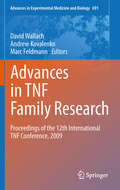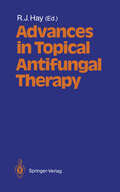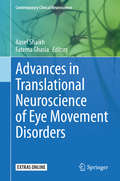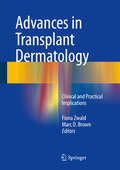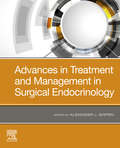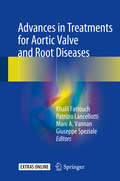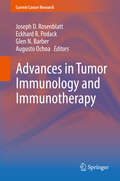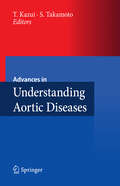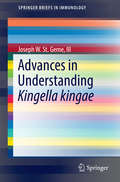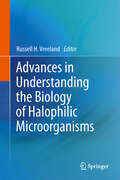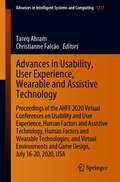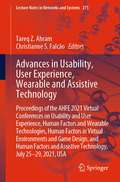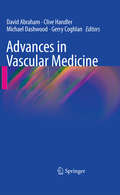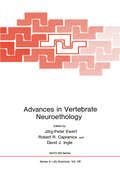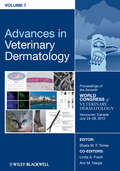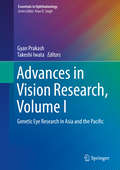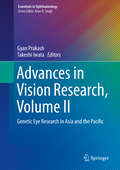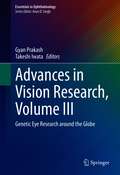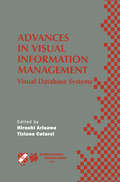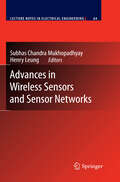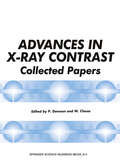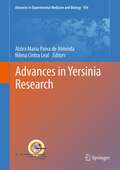- Table View
- List View
Advances in TNF Family Research: Proceedings of the 12th International TNF Conference, 2009 (Advances in Experimental Medicine and Biology #691)
by David Wallach, Andrew Kovalenko and Marc FeldmannThe biennial TNF-family conferences have been held over the past 20 years, from the time that TNF was cloned. These meetings have followed the enormous progress in this field. Much is now known about the members of the TNF ligand and receptor families, their signaling proteins, mechanisms of action and cellular functions. This volume is the proceedings of the 12th TNF International Conference, held in April 2009. This conference focuses on the physiological, pathophysiological, and medical significance of these important regulators. Sessions at the meeting specifically address their involvement in immunity, development, apoptosis, autoimmunity, cancer, and infection, the normal function and pathology of the neuronal system, as well as major unresolved questions about their mechanisms of action.
Advances in Topical Antifungal Therapy
by R. J. HayR.J. Hay Institute of Dermatology, United Medical and Dental Schools of Guy's and St. Thomas's Hospitals, 5 Lisle Street, London WC2H 7BJ, Great Britain It is a problem familiar to all dermatologists, as with other physi cians, that a large number of common diseases can be alleviated or improved but not cured. Infections, particularly those caused by bacteria or fungi, may appear at first to be different, as in many cases it is possible to destroy the causative organism with antibio tics to produce a remission or cure. However, the reality is less simple and many problems continue to beset therapy. Firstly, in approaching the treatment of fungal infections it is important to assess the role of the fungi isolated in the pathogenesis of the disease in order to choose the most appropri ate therapy. While the invasion of the stratum corneum or struct ures derived from the epidermis, such as hair or nail, is the main consequence of infection in superficial mycoses, fungi may also cause disease indirectly or in combination with other micro-organ isms. In some instances several organisms are apparently involved in the pathogenesis of skin disease such as chronic paronychia [1].
Advances in Toxicology and Risk Assessment of Nanomaterials and Emerging Contaminants
by Liang-Hong Guo Monika MortimerThis book details the state-of-the-art methodological advances for delineating the toxicology and working mechanisms of nanomaterials, microplastics, fine aerosol particulates (PM2.5) as well as emerging organic pollutants. It also provides latest computational approaches for toxicity prediction and risk assessment of nanoscale materials which possess realistic chances to enter the environment and human organism. Written by leading scientists at the frontiers of environmental science and nanomedicine, this book is intended for both young researchers and experienced professionals working in the fields of environmental protection, human health and occupational safety, nanotechnology, material science and nanomedicine, as well as graduate students majoring in environmental and health sciences.
Advances in Translational Neuroscience of Eye Movement Disorders (Contemporary Clinical Neuroscience)
by Aasef Shaikh Fatema GhasiaA comprehensive book that reviews advances in ocular motor research on topics of general interest, rare, specialized or unique conditions, and pertinent basic neuroscience. A rare collection with contributions from basic neuroscientists, neurologists, and ophthalmologists. Includes dedicated chapters on mathematical models, pharmacotherapy, neuromodulation, motion perception, visual influence on eye movement, physiology of strabismus, and microsaccades. This book is dedicated to David Robinson - one of the pioneers of contemporary ocular motor and vestibular neuroscience.
Advances in Transplant Dermatology: Clinical and Practical Implications
by Fiona Zwald Marc D. BrownThis book provides an informative update on scientific advances relating to transplant dermatology that may be applicable to clinical practice. Commentary is provided on the emerging role of viruses in transplant dermatology, the management of skin disease secondary to transplant medication, sunscreen use in transplant recipients, the role of revision of immunosuppression, and advances in photodynamic therapy. The latest staging and management criteria for high-risk squamous cell carcinoma and the implications for clinical practice are then analyzed. Finally, the management of other cutaneous malignancies is discussed, covering malignant melanoma, Merkel cell carcinoma, and rarer tumors that also behave aggressively and require special consideration in solid organ transplant patients. Each particular advance is addressed in an individual chapter by leaders in the field. The book both expands current knowledge and complements previous textbooks on the subject.
Advances in Treatment and Management in Surgical Endocrinology E-Book
by Alexander L. ShifrinUp-to-date and evidence-based, Updates on Treatment and Management of Endocrinopathies [correct title?] provides an overview of recent developments regarding the most prevalent endocrine disorders. A concise, easy-to-read reference for endocrinologists and endocrine surgeons, this timely reference includes an overview of each disorder as well as diagnosis, management, treatment, prognosis, and a summary by a renowned expert who has contributed to the most current literature.Addresses endocrine diseases of the thyroid, parathyroid, and adrenal glands as well as familial endocrine syndromes: multiple endocrine neoplasia type 1 and 2 (MEN). Includes both surgical and nonsurgical treatments. Consolidates today's available information on this timely topic into one convenient resource.
Advances in Treatments for Aortic Valve and Root Diseases
by Giuseppe Speziale Mani A. Vannan Patrizio Lancellotti Khalil FattouchThis book describes the different aspects of aortic valve and root diseases including comprehensive discussion of the state-of-the-art diagnostic imaging options, disease risk stratification, selection of candidates for valve repair or percutaneous intervention, and most recent therapeutic options. The growing prevalence of valvular heart disease represents a major challenge in terms of short- and long-term management and surveillance. Aortic valve diseases, including aortic stenosis and regurgitation, are among the most frequent of these, while the number of cases of aortic root disease is also on the rise. Aortic valve disease treatment options include valve surgery, valve repair, minimally invasive valve surgery, and percutaneous approaches and all are covered in this volume.Advances in Treatments for Aortic Valve and Root Diseases is a highly illustrated, case oriented reference aimed at cardiology fellows in training, while also helpful to surgeons, cardiologists, imagers, interventionalists, as well as other clinicians and students involved in the diagnosis and treatment of aortic valve and root diseases.
Advances in Tumor Immunology and Immunotherapy (Current Cancer Research)
by Joseph D. Rosenblatt Eckhard R. Podack Glen N. Barber Augusto OchoaRecent advances in understanding of fundamental immunology have created new insights into the dynamic interactions between tumors and the immune system. This includes new understanding of T- and B-cell interaction, immune inhibitory mechanisms including the biology of T regulatory cells, myeloid suppressor cells, and dendritic cell subsets. Enhanced understanding of mechanisms underlying T-cell anergy such as arginine deprivation, immunosuppressive cytokines, defective innate and interferon response pathways, and NKG2D downregulation have all provided new insight into suppression of anti-tumor immunity and tumor evasion. In addition to emerging understanding of tumor evasion, new immune targets such as CTLA4 blockade, NK stimulatory receptors, manipulation of the antigen processing and presentation, cytokine and costimulatory responses all provide new possibilities for enhancing anti-tumor immunity even in tumors previously felt to be resistant to immune attack. Several of these strategies have already been realized in the clinic. The volume will explore evolving paradigms in antigen presentation, dendritic cell biology, the innate response and immunosuppressive mechanisms, and emerging strategies for manipulation of the immune system for therapeutic benefit that have realized success in neuroblastoma, leukemia, melanoma, lung cancer, and allogeneic transplantation. Early successes as well as failures will be highlighted to provide a snapshot of the state of clinical immunotherapy with an eye to future possibilities such as combination therapies, adoptive T-cell transfer, and the retargeting of immune cells via T-cell receptor engineering.
Advances in Understanding Aortic Diseases
by Teruhisa Kazui Shinichi TakamotoFollowing the first international symposium ever held in Asia on Advances in Understanding Aortic Diseases (AUAD), this volume of proceedings contains the papers presented in both the oral and poster sessions. The 8th AUAD symposium greatly contributed to the understanding of aortic diseases, especially in Asia. Aortic diseases, specifically thoracic aortic diseases, are more common in Japan than in Western countries, which adds further importance to this compilation that covers recent improvements and advances in thoracic aortic surgery and its outcomes. Divided into lectures, panel discussions, symposiums, and poster sessions, the book includes, among other topics, advances in imaging and diagnosis with 3D-CT, MRS, and US; state-of-the-art repair of the thoracic aorta; novel aspects of aortic root replacement; reconstruction; and prosthetic graft surgery. This valuable collection of work provides the reader with an increased knowledge and understanding of aortic diseases not only in Japan but worldwide.
Advances in Understanding Kingella kingae (SpringerBriefs in Immunology)
by Joseph W. St. GemeThis book describes the growing body of information on the epidemiology, clinical manifestations, transmission, pathogenesis, diagnosis, and treatment of Kingella kingae infections in young children. In addition, it covers experimental methods that have been developed to study the microbiology, genetics, and virulence factors of K. kingae, information that provides the foundation for new approaches to treatment and prevention of K. kingae disease. With this content in mind, excerpts from the book will be of relevance for clinicians who care for pediatric patients, for clinical microbiologists who are involved in detecting organisms in clinical specimens, and for scientists who are studying K. kingae in an effort to develop novel targets for antimicrobial therapy and new approaches to prevention.First isolated in the 1960s by Elizabeth O. King, a bacteriologist at the CDC, Kingella kingae was largely ignored over the next two decades as a human pathogen because of its uncommon recovery from patients with disease. However, in recent years K. kingae has been increasingly recognized as a clinically important pathogen in young children, and is currently recognized as the leading cause of osteoarticular infections in young children in a growing number of countries. Research into this organism has grown tremendously over the past 15 years, resulting in a better appreciation of the importance of K. kingae in pediatric patients and of the molecular mechanisms of disease.
Advances in Understanding Mechanisms and Treatment of Infantile Forms of Nystagmus
by R. John Leigh Michael W. DevereauxThis volume brings together work from leading researchers in the fields of developmental disorders of binocular vision, strabismus, and both infantile and acquired forms of nystagmus. It contains four sections. The first section, Basic Concepts of Stable Vision and Gaze, deals with psychophysical aspects of infantile forms of nystagmus and the relative contributions of extraocular proprioception and efference (corollary discharge). It also contains an accessible review of current notions of spatial and temporal visual functions and spatial constancy in infantile nystagmus syndrome and latent nystagmus. The second section, New Models and Techniques for Studying Gaze Stability, reviews animal and development models for strabismus, amblyopia, and nystagmus. It also contains novel optical methods for managing the visual consequences of nystagmus and a study of the potential ill effects of video displays on children's response to near viewing. The third section, New Therapies for Congenital Nystagmus, presents basic genetic studies and clinical trials of drug and surgical treatment of those patients with infantile forms of nystagmus. The final section,General Aspects of Normal and Abnormal Gaze Control, pulls together a range of contributions dealing with normal gaze control, infantile nystagmus, and acquired disorders of eye movements, including new treatment measures. This book will be a valuable resource for all scientists and practitioners interested in developmental disorders of vision.
Advances in Understanding the Biology of Halophilic Microorganisms
by Russell H. VreelandThis book is designed to be a long term career reference. The chapters present modern procedures. This is a how-to-book with a difference. These chapters: - reveal the background information about working with salt loving organisms, - are loaded with information about how experiments are conducted under high salt, - provide information about analyses that work under these conditions and those that may not, - present a wide range of details from laboratory designs to equipment used and even to simple anecdotal hints that can only come from experience. Microbiological training focuses largely on the growth, the handling and the study of the microbes associated with humans and animals. Yet the largest proportion of the Earth’s microbiota lives in saline environments such as the Oceans, saline deserts and terminal hypersaline environments. This need for salt can be intimidating for those interested in entering the field or for those interested in understanding how such research is accomplished.
Advances in Usability, User Experience, Wearable and Assistive Technology: Proceedings of the AHFE 2020 Virtual Conferences on Usability and User Experience, Human Factors and Assistive Technology, Human Factors and Wearable Technologies, and Virtual Environments and Game Design, July 16-20, 2020, USA (Advances in Intelligent Systems and Computing #1217)
by Tareq Ahram Christianne FalcãoThis book addresses emerging issues in usability, interface design, human–computer interaction, user experience and assistive technology. It highlights research aimed at understanding human interactions with products, services and systems and focuses on finding effective approaches for improving the user experience. It also discusses key issues in designing and providing assistive devices and services for individuals with disabilities or impairment, offering them support with mobility, communication, positioning, environmental control and daily living. The book covers modeling as well as innovative design concepts, with a special emphasis on user-centered design, and design for specific populations, particularly the elderly. Further topics include virtual reality, digital environments, gaming, heuristic evaluation and forms of device interface feedback (e.g. visual and haptic). Based on the AHFE 2020 Virtual Conference on Usability and User Experience, the AHFE 2020 Virtual Conference on Human Factors and Assistive Technology, the AHFE Virtual Conference on Human Factors and Wearable Technologies, and the AHFE 2020 Virtual Conference on Virtual Environments and Game Design, held on July 16–20, 2020, it provides academics and professionals with an extensive source of information and a timely guide to tools, applications and future challenges in these fields.
Advances in Usability, User Experience, Wearable and Assistive Technology: Proceedings of the AHFE 2021 Virtual Conferences on Usability and User Experience, Human Factors and Wearable Technologies, Human Factors in Virtual Environments and Game Design, and Human Factors and Assistive Technology, July 25-29, 2021, USA (Lecture Notes in Networks and Systems #275)
by Tareq Z. Ahram Christianne S. FalcãoThis book addresses emerging issues in usability, interface design, human–computer interaction, user experience and assistive technology. It highlights research aimed at understanding human interactions with products, services and systems and focuses on finding effective approaches for improving the user experience. It also discusses key issues in designing and providing assistive devices and services for individuals with disabilities or impairment, offering them support with mobility, communication, positioning, environmental control and daily living. The book covers modeling as well as innovative design concepts, with a special emphasis on user-centered design, and design for specific populations, particularly the elderly. Further topics include virtual reality, digital environments, gaming, heuristic evaluation and forms of device interface feedback (e.g. visual and haptic). Based on the AHFE 2021 Conferences on Usability and User Experience, Human Factors and Wearable Technologies, Human Factors in Virtual Environments and Game Design, and Human Factors and Assistive Technology, held virtually on 25–29 July, 2021, from USA, this book provides academics and professionals with an extensive source of information and a timely guide to tools, applications and future challenges in these fields.
Advances in Vascular Medicine
by David Abraham Handler Clive Michael Dashwood Gerry CoghlanUnderstanding the many complex cellular and molecular mechanisms underlying human vascular diseases is essential in improving the treatment of this important and wide-ranging group of diseases that affect a large proportion of the world po- lation. This book is based on lectures presented at an International Vascular Biology Workshop held in London and chaired by Professor Dame Carol Black. The c- tents are complemented by some invited chapters, all written by world experts in areas of basic science and clinical medicine highly relevant to vascular biology and disease. We are particularly grateful to Professor Arshed Quyyumi, Professor of Medicine and Cardiology at Emory University, who with his research group and clinical colleagues, has provided a substantial contribution to this book. In common with our previous book – Vascular Complications in Human Disease: Mechanisms and Consequences published by Springer in 2008, our aim with this book is to highlight some of the established relationships between basic science and clinical medicine, and to outline new and exciting fields of research and practice in vascular biology and pathobiology. There are two sections: Basic Science of Vascular Biology and Clinical Aspects of Vascular Biology. In the first section, dealing with basic science, we have included three important growth areas: “Genetics and Gene Therapy” cover approaches to gene therapy and delivery systems, “Animal Models to Study Vascular Disease” with chapters on animal models of scleroderma, animal models of atherosclerosis, and finally on the endothelin system.
Advances in Vertebrate Neuroethology (Nato Science Series A: #56)
by Jorg-Peter EwertThis volume presents the proceedings of the NATO Advanced Study Institute on "Advances in Vertebrate Neuroethology" held at the University of Kassel, Federal Republic of Germany in August 1981. During the last decade much progress has been made in understanding the neurophysiological bases of behavior in both vertebrates and invertebrates. The reason for this is that a number of new physiological, anatomical, and histochemical techniques have recently been developed for brain research which can now be combined with ethological methods for the analysis of animal behavior to form a new field of research known as "Neuroethology". The term Neuroethology was originally introduced by S.L.Brown and R.W.Hunsperger (1963) in connection with studies on the activation of agonistic behaviors by electrical brain stimulation in cats. Neuroethology was more closely defined by G.Hoyle (1970) in the context of a review on cellular mechanisms underlying behavior of invertebrates. Since the 6th annual meeting of the Society for Neuroscience held in Toronto in 1976, Neuroethology has become established as a session topic.
Advances in Veterinary Dermatology, Volume 7: Proceedings of the Seventh World Congress of Veterinary Dermatology, Vancouver, Canada, July 24 - 28, 2012
by Sheila M. F. TorresRepresenting the state of the art of veterinary dermatology around the globe, Advances in Veterinary Dermatology, Volume 7, presents selected scientific papers from the Seventh World Congress of Veterinary Dermatology. The Congress, held in Vancouver, Canada in July 2012, was organized with the support of the World Association for Veterinary Dermatology (WAVD) and its affiliated societies. A record number of delegates attended from over 50 countries to take advantage of the exceptional scientific program. Cutting edge information was presented as review papers and original studies in the areas of: Allergy Immunology Skin Biology Therapy Infectious Diseases Oncology These peer-reviewed and edited papers were published in the journal Veterinary Dermatology in volume 24, issue 1, and are included in this hardbound book volume of the conference proceedings. Also included are 13 Workshop Reports which summarise sessions where experts presented topics in various areas providing a wonderful opportunity for colleagues to ask questions and exchange ideas in an informal atmosphere. A vital resource for all practising veterinarians and researchers interested in the field of veterinary dermatology.
Advances in Veterinary Dermatology, Volume 7: Proceedings of the Seventh World Congress of Veterinary Dermatology, Vancouver, Canada, July 24 - 28, 2012
by Sheila M. F. Torres Linda A. Frank Ann M. HargisRepresenting the state of the art of veterinary dermatology around the globe, Advances in Veterinary Dermatology, Volume 7, presents selected scientific papers from the Seventh World Congress of Veterinary Dermatology. The Congress, held in Vancouver, Canada in July 2012, was organized with the support of the World Association for Veterinary Dermatology (WAVD) and its affiliated societies. A record number of delegates attended from over 50 countries to take advantage of the exceptional scientific program. Cutting edge information was presented as review papers and original studies in the areas of: Allergy Immunology Skin Biology Therapy Infectious Diseases Oncology These peer-reviewed and edited papers were published in the journal Veterinary Dermatology in volume 24, issue 1, and are included in this hardbound book volume of the conference proceedings. Also included are 13 Workshop Reports which summarise sessions where experts presented topics in various areas providing a wonderful opportunity for colleagues to ask questions and exchange ideas in an informal atmosphere. A vital resource for all practising veterinarians and researchers interested in the field of veterinary dermatology.
Advances in Vision Research, Volume I: Genetic Eye Research in Asia and the Pacific (Essentials in Ophthalmology)
by Gyan Prakash Takeshi IwataThis book presents the state of the art in genetic eye research in Asia and the Pacific. Though there has been an explosion of information on genetic eye research in western countries, more than sixty percent of the human genes involved in eye diseases in the Asian and Pacific population remain unknown. However, new efforts and a new awareness have sparked important discussions on the subject, and new plans are being implemented to discover the genes responsible for many eye diseases in the population. The book reviews the latest findings; its content ranges from genetic aspects of human migration to DNA sequence analysis, genome-wide association analysis, and disease phenotypes. The efforts of the Asian Eye Genetic Consortium (AEGC) are also discussed. The book’s editors have been instrumental in developing strategies for discovering the new Asian genes involved in many eye diseases. All chapters were written by leading researchers working on Asian eye genetics from the fields of Human Genetics, Ophthalmology, Molecular Biology, Biochemistry, Sensory Sciences, and Clinical Research. Advances in Vision Research, Volume I will prove to be a major resource for all researchers, clinicians, clinical researchers, and allied eye health professionals with an interest in eye diseases among the Asian population.
Advances in Vision Research, Volume II: Genetic Eye Research In Asia And The Pacific (Essentials In Ophthalmology Ser.)
by Gyan Prakash Takeshi IwataThis second volume continues with a focus on the state of the art in genetic eye research in Asia and the Pacific. Though there has been an explosion of information on genetic eye research in western countries, more than sixty percent of the human genes involved in eye diseases in the Asian and Pacific population remain unknown. However, new efforts and a new awareness have sparked important discussions on the subject, and new plans are being implemented to discover the genes responsible for many eye diseases in the population. The book reviews the latest findings; its content ranges from genetic aspects of human migration to DNA sequence analysis, genome-wide association analysis, and disease phenotypes. The efforts of the Asian Eye Genetic Consortium (AEGC) are also discussed. The book’s editors have been instrumental in developing strategies for discovering the new Asian genes involved in many eye diseases. All chapters were written by leading researchers working on Asian eye genetics from the fields of Human Genetics, Ophthalmology, Molecular Biology, Biochemistry, Sensory Sciences, and Clinical Research. Advances in Vision Research, Volume II will prove to be a major resource for all researchers, clinicians, clinical researchers, and allied eye health professionals with an interest in eye diseases among the Asian population.
Advances in Vision Research, Volume III: Genetic Eye Research around the Globe (Essentials in Ophthalmology)
by Gyan Prakash Takeshi IwataThis third volume, with three supporting editors, broadens its focus on genetic eye research from the Asian to the global scale. New efforts and a new awareness have sparked important discussions on genetic eye research, and new plans are being implemented to identify the genes responsible for numerous eye diseases. The book introduces the latest findings on genetics in eye diseases, gene therapy, and genome-wide association analysis, and the efforts of the Global Eye Genetic Consortium (GEGC). The book’s editors have been instrumental in developing strategies for discovering the new genes involved in many eye diseases. All chapters were written by leading researchers working on eye genetics from the fields of Human Genetics, Ophthalmology, Molecular Biology, Biochemistry, Sensory Sciences, and Clinical Research. Advances in Vision Research, Volume III is a major resource for all researchers, clinicians, clinical researchers, and allied eye health professionals with an interest in eye diseases around the globe.
Advances in Visual Information Management: Visual Database Systems. IFIP TC2 WG2.6 Fifth Working Conference on Visual Database Systems May 10–12, 2000, Fukuoka, Japan (IFIP Advances in Information and Communication Technology #40)
by Hiroshi Arisawa Tiziana CatarciVideo segmentation is the most fundamental process for appropriate index ing and retrieval of video intervals. In general, video streams are composed 1 of shots delimited by physical shot boundaries. Substantial work has been done on how to detect such shot boundaries automatically (Arman et aI. , 1993) (Zhang et aI. , 1993) (Zhang et aI. , 1995) (Kobla et aI. , 1997). Through the inte gration of technologies such as image processing, speech/character recognition and natural language understanding, keywords can be extracted and associated with these shots for indexing (Wactlar et aI. , 1996). A single shot, however, rarely carries enough amount of information to be meaningful by itself. Usu ally, it is a semantically meaningful interval that most users are interested in re trieving. Generally, such meaningful intervals span several consecutive shots. There hardly exists any efficient and reliable technique, either automatic or manual, to identify all semantically meaningful intervals within a video stream. Works by (Smith and Davenport, 1992) (Oomoto and Tanaka, 1993) (Weiss et aI. , 1995) (Hjelsvold et aI. , 1996) suggest manually defining all such inter vals in the database in advance. However, even an hour long video may have an indefinite number of meaningful intervals. Moreover, video data is multi interpretative. Therefore, given a query, what is a meaningful interval to an annotator may not be meaningful to the user who issues the query. In practice, manual indexing of meaningful intervals is labour intensive and inadequate.
Advances in Wireless Sensors and Sensor Networks (Lecture Notes in Electrical Engineering #64)
by Subhas Chandra Mukhopadhyay Henry LeungIn recent times wireless sensors and sensor networks have become a great interest to research, scientific and technological community. Though the sensor networks have been in place for more than a few decades now, the wireless domain has opened up a whole new application spaces of sensors. Wireless sensors and sensor networks are different from traditional wireless networks as well computer networks and therefore pose more challenges to solve such as limited energy, restricted life time, etc. This book intends to illustrate and to collect recent advances in wireless sensors and sensor networks, not as an encyclopedia but as clever support for scientists, students and researchers in order to stimulate exchange and discussions for further developments.
Advances in X-Ray Contrast: Collected Papers
by P. Dawson and W. ClaussFor all that new non-X-ray technologies such as MR and ultrasound and its various manifestations have made an enormous impact in recent years on the practice of medical imaging, the use of X-rays and X-ray contrast-enhancing agents has retained an important position at the heart of the process. Indeed, with its frequent requirements for high total dose regimes, CT has increased the use of contrast agents. Even helical/spiral CT which, it was initially argued, should reduce contrast as well as radiation loads, may actually require just as much or more of both because of the potential it offers for multi-phase scanning. Iodinated intravascular X-ray contrast agents, especially the more recently developed non-ionic agents, continue therefore to play a pivotal role in clinical imaging. These succinct and authoritative articles, originally appearing in the journal Advances in X-ray Contrast, range sufficiently widely for their compilation in this volume to be considered a mini-textbook on the water-soluble iodinated X-ray contrast agents and their applications. Each is written by an acknowledged and experienced expert in the field. They usefully cover the developmental history of the agents; defined risk factors, approaches to prophylaxis and, ultimately, of the treatment of adverse reactions; the interesting subject of supposed delayed reactions to contrast agents; the important organ-specific toxicities, cardiac toxicity, neurotoxicity and nephrotoxicity and high-dose toxicity as encountered in complex procedures; the sometimes special circumstances and occasional extreme conditions to which contrast agents may be exposed in Interventional Radiology; the special, in several ways, case of paediatric radiology; the controversial subject of thromboembolic phenomena in clinical angiography; and the precise role of contrast agents. As regards the practicalities of contrast administration regimes and imaging protocols it is really only in the area of CT that there is debate and controversy, and articles are included which cover CT of the liver, spleen and pancreas, and protocols for the new spiral/helical technology and even for the much less widely available electron-beam CT technology visualization. Pulmonary embolus diagnosis and protocols for contrast administration with this technology are also discussed.
Advances in Yersinia Research (Advances in Experimental Medicine and Biology #954)
by Alzira Maria Paiva de Almeida and Nilma Cintra LealThis book is a collection of articles written by prominent scientists who gathered in the city of Recife, Brazil, 23-27 October 2010, celebrating the 10th International Symposium on Yersinia. The event is held every four years in a different country and for the Yersinia 2010, an interesting and updated program covering advances in research in Yersiniae was organized. The major advances achieved over the past four years since the last symposium held in Lexington, USA in 2006 were divided into eight chapters: Epidemiology, Clinical, Diagnostic and Therapeutic aspects; Ecology and Modeling; Genomic/Transcriptomics and Large Scale Population; Immune Response and Vaccine; Pathogenesis and Pathogenicity Factors; Cellular Yersiniology; Bacterial Structure and Metabolism: Roles in Pathogenesis and Bacterial Life Style. The purpose of the book is to extend cutting edge knowledge on Yersinia discussed during the 10th International Symposium.
